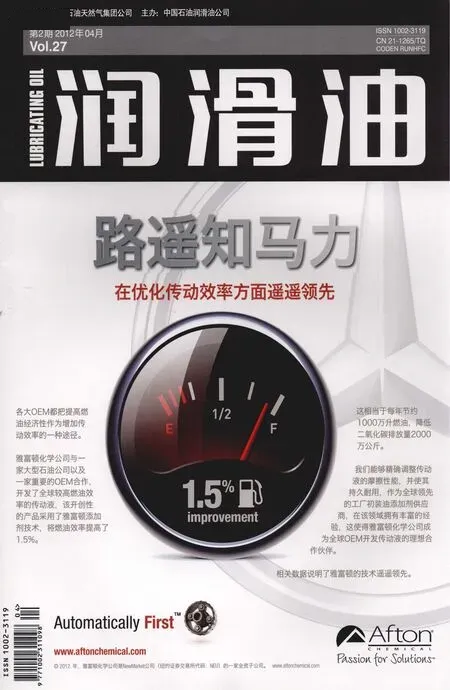Developing Additive Technology for Wet Dual Clutch Transm issions
2012-01-04HongZhiTangRamnathIyerSamuelTersigniPhilippeEzannoChristopherCleveland
Hong-Zhi Tang,Ramnath Iyer,Samuel H.Tersigni,Philippe Ezanno,Christopher S.Cleveland
(Afton Chemical Corporation,Richmond,VA 23219,USA)
Developing Additive Technology for Wet Dual Clutch Transm issions
Hong-Zhi Tang,Ramnath Iyer,Samuel H.Tersigni,Philippe Ezanno,Christopher S.Cleveland
(Afton Chemical Corporation,Richmond,VA 23219,USA)
Wet dual clutch transmissions(W-DCTs)show overall benefits including excellent fuel efficiency,wide torque capacity range,long durability,driving com fort and sportiness.Many breakthroughs have beenmade to further improve the fuel efficiency by design innovations and introductionsof new hardware.Each W-DCT has its unique design and hardware.It demands the lubricant to provide excellentwet clutch friction performance and anti-shudder friction durability,good synchronizer friction performance and durability,high load-carrying ability,excellent bearing performance,strong anti-corrosion performance,high thermal and oxidative stability,excellentmaterial compatibility,etc.Particularly,the requirement of the wet clutch friction performance in W-DCT ismuch more severe than conventional ATFs and CVTFs.We report here our latestW-DCTF technologies developed for differentW-DCT app lications.DCTF-1 was optim ized for a two-sump W-DCT application with the clutch lining material of friction material A(FM-A).DCTF-1 shows high and stable dynam ic friction,static friction,particularly,high quasi-static friction without any shudder tendency in GK tests.DCTF-2 was designed for a one-sump W-DCT app lication with the same clutch liningmaterial of FM-A.DCTF-2 completes 42,000 cycles of the severe GTI chassis dynamometer vehicle testwithout any issues,which is comparable to the factory fill fluid DCTF-FF.DCTF-3 was developed for a one-sump W-DCT application with a different clutch liningmaterial of FM-B.DCTF-3 shows high and stable dynamic friction in the severe newly developed SAE DCT test procedure.DCTF-3 also gives excellent LVFA durability of over 720 h in the JASO M 349 test procedure on FM-B.
dual clutch transmission;DCT fluid;friction durability
0 Introduction
Original equipment manufacturers(OEMs)design or purchase transmissions based on fuel economy,packaging,cost,driving com fort,torque transmitting capability,transmission durability,etc.Manual transmission(MT)features high mechanical efficiency,robustness,cost-effectiveness,and a wide range of torque transmitting capability,but suffers the driving comfort due to the power interruption during gear shifting.Automated manual transmission(AMT)improves,to some extent,the driving com fort,but does not reach the comfort level of stepped automatic transmission(AT),continuously variable transmission(CVT),and dual clutch transmission(DCT)yet.Stepped AT shows good durability,a wide range of torque transmitting capability,excellent driving comfort and improved efficiency,particularly,when the transmission haswider gear ratios.However,more gear ratios need a larger packaging space and extra costs.CVT has excellent driving com fort.But itwas reported that CVT has theworst overall efficiency because of low transmission efficiency,when different transmission configurations and the percentage of energy available from the fuel that actually reaches the wheels are compared,although it canmake the engine running in the best operating region[1-2].The pump power loss is significant,compared to other transmissions.Additionally,CVT has a limitation on the torque transmitting capability of less than 350 Nm.To extend the torque transmitting capability,OEMs demand a special CVT fluid with higher steel/steel friction,for example,the higher pulley/element friction in push belt CVTs,whichmakes the fluid have relatively poorer wet clutch and torque converter friction performance and durability.Figure 1 illustrates the configuration of a DCT design.In the DCT,one wet clutch manages the odd and reverse gears,while the other controls the even gears.When shifting gears,the current gear remains engaged while the next gear is being selected.This removes the torque interrupt experienced in MTs,and significantly improves the fuel efficiency.DCT is the only automatic transmission that brings the fuel efficiency up to an extent such that it is comparable to or even higher than that of amanual transmission while offering high driving com fort and sportiness.
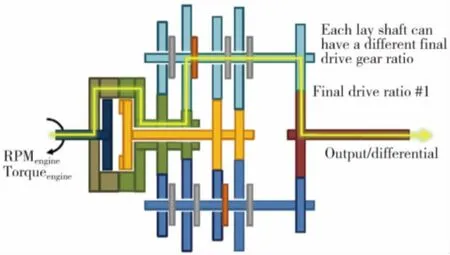
Figure 1 Typica l layout of a dual clutch transm ission (Courtesy of Professor Timothy M.Cameron,Miami University of Ohio)
DCTs can be classified into dry DCTswith dry clutches,and wet DCTswithwet clutches lubricated and cooled by DCT fluids(W-DCTFs).Dry clutches offer significant reduction in parasitic lossesof the open clutch in DCTs,for example,no pump loss and less drag loss,yet the stability of friction characteristics,thermal management and durability are generally inferior to wet clutches.Dry clutches can only be used in small automobile application.Compared to dry DCTs,wet DCTs offer the advantages of high thermal robustness,NVH improvement by utilizing the clutch slip control,and a wide range of torque transmitting capability.Recently,some OEMs started working on electric hybrid DCTs.Electric hybrid DCTs can achieve further reductions in oil consumption and emissions.However,hybrid electric vehicles bring new challenges in terms of configuring and dimensioning transmissions,cost,and transmission reliability[3].
Due to the overall advantages of wet DCTs,large OEMs have launched wet DCTs,such as Audi,Mitsubishi,Nissan,BMW,and Porsche after the first introduction of the Volkswagen Direct Shift Gearbox(DSG)in 2002.More wet DCTs are expected to be launched in the near future.To achieve better fuel efficiency,various breakthroughs have beenmade,for example,optimizing the clutch drag and pump losses leads to 4.7%fuel efficiency improvement,compared to the first generation DCT using hydraulics with an engine driven pump for actuation and lubrication.The third generation DCT,consisting of a hydraulic actuation with a power pack,an electric on-demand lubrication pump and a one way clutch at the first gear,shows an additional 4.1%fuel efficiency improvement[2].In addition to various new DCT designs,new transmission parts have been adopted to have additional options or to deliver improved DCT performance.For example,in addition to the friction liningmaterial(FM-A)used in VW GTI vehicles,another friction material(FM-B)was introduced in Mitsubishi Fuso DCT application in 2010.
Wet DCTs can be classified into two-sump and onesump DCTs according to the number of oil sumps.In the two-sump DCT,the clutch pack and the gear box have their own oil sumps and different fluids,respectively.The one-sump DCT has a single fluid to lubricate and to cool both the clutch pack and the gear box.More OEMs have been working on one-sump wet DCTs.
In wet DCTs,the clutch packs are used both for launching and shifting.It is essential thatW-DCTFs provide ample lubrication and friction durability for the clutch packs and synchronizers,anti-wear protection for all parts,and thermal cooling of the entire system.To protect and extend the use of various new wet DCT designs and parts selected,additive suppliers and oil companies have been working on optimizing the fluid technology to deliver improved fluid performance.We have done extensive fluid engineering to develop various fluid technologies for differentwetDCT designs.We here report our methodology of fluid engineering and the latest customized fluid technologies.
1 Methodology of Fluid Engineering
1.1 Functions of DCTFs
W-DCTFs are very different from MTFs and conventional ATFs.W-DCTFsmust provide sufficient wear protection for the helical gears,and good friction characteristics and wear protection for the synchronizers,which are not required by ATFs.Different to MTFs,W-DCTFsmust provide good wet clutch friction characteristics and durability.For good fuel efficiency,W-DCTFs must be sufficiently low in viscosity at high and low temperatures,which has to be balanced with wear protection.W-DCTFs thereforemust have the functions including controlling dual clutch friction performance,controlling synchronizer friction performance,lubricating gears,bearings,and shafts,hydraulically actuating clutches and synchronizers,minimizing componentwear and corrosion,cooling or thermally controlling the system,and protecting other parts like seals(Figure 2).
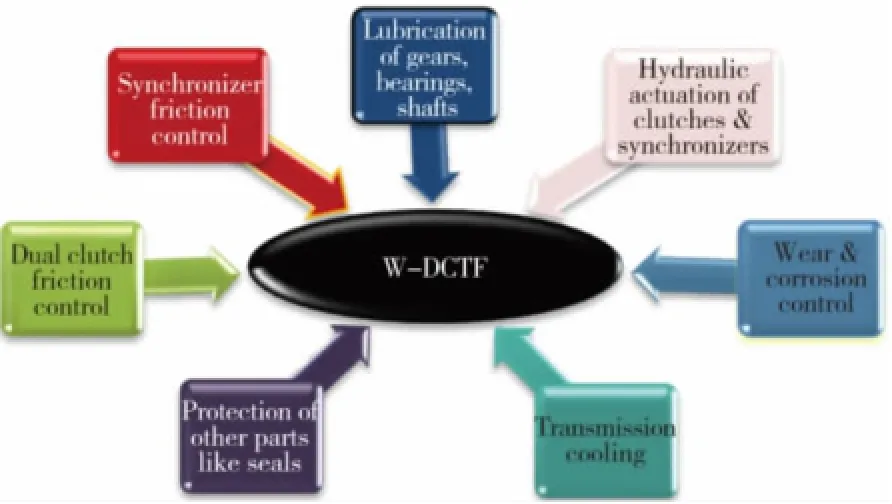
Figure 2 Functions ofW-DCTFs
1.2 Demanding Wet Clutch Friction Performance
The dual clutcheswork as the start-up and gear shifting device,which is probably themost critical component inWDCTs.For each shift,both clutches need to be engaged and disengaged simultaneously,leading to an estimated 2 million shifts over the transmission life.The launch mode is particularly severe and accounts for~80%of the frictional impacton the clutch,making high performance friction materials and an optimized lubricant cooling system necessary[4-5].
The dual clutches require demanding friction performance,which ismuchmore severe than that ofwet clutches in stepped ATs.Stepped AT generally uses a torque converter as the launch device and several clutches for gear shifting and torque holding.These clutches share the functions of the dual clutches in wet DCTs.JASO M348 is an industry standard friction test to approve the fluid's suitability to be used in wet clutches,for example,used in stepped ATs and CVTs.JASO M348 requires the dynamic friction ratio ofμ0/μdbe less than 1.1 to make sure the fluid have enough anti-shudder performance.However,all OEMs working on wet DCTs demand the dynamic friction ratio ofμ0/μdbe less than 1.0 in much more severe test conditions,for example,higher sump temperatures,higher energy inputs,and longer durability test cycles.
W-DCTs demand the following friction characteristics: 1)positiveμ-V friction curves,i.e.,coefficient of friction increasing with the sliding speed increase,in all operating conditions to avoid any noise-vibration-harshness(NVH) issues;2)extremely durable friction level tomake sure quick and smooth gear shifts in the whole DCT life;and 3)high static or quasi-static friction in all operating conditions provided that the clutch performancemeets the above two requirements.
1.3 Factors Affecting the Wet Clutch Perfo rmance
The friction characteristics are determined by the friction liningmaterials,separator steel plates,their geometry and sizes,operating limits like temperatures and pressures,thermal management system,energy inputs,lubricants,and others.Particularly,W-DCTFs and friction plates have significant impacts on the friction performance.Friction platesmay have different liningmaterials,thicknesses,grooves,waves,diameters,surface treatments,pore size and its distributions,elasticity,etc.The liningmaterials contain fibers,frictionmodifiers,solid lubricates,and binders[6].On the other hand,as shown in Figure 3,W-DCTFs typically contain dispersants,friction modifiers,detergents,anti-foam agents,anti-wear and EP components,viscosity index improvers,anti-oxidants,and base oils.

Figure 3 Typical components in W-DCTFs
All these factors have significant and different impacts on the friction characteristics.For example,the total friction during a clutch engagement is the sum of hydrodynamic and asperity friction.At the beginning of the engagement,the friction performance is mainly controlled by the permeability,compressibility,grooves,and surface smoothness of the lining materials.At the end of the engagement,the friction performance is controlled by theW-DCTF additives,frictionmaterial chemicaland physical effects,smoothness and uniformity of the lining materials,and the fluid tribo films[6].The DCTF plays amajor part in controlling the frictional response.The bulk properties of the lubricanthave a greater effect during the hydrodynamic phase.The friction modifiers and other surface active components in the additive package aremainly responsible for controlling friction at the low-speed end of the engagement.The dynamic friction value strongly influences the resultant clutch torque capacity.The static friction value,which is significantly affected by the interactions between friction liningmaterials and friction modifiers and other surface active components like detergents in the DCTF,determines the holding capacity of a clutch.
1.4 Unique W-DCTF Specifications
OEMs have their uniqueW-DCT designs and parts selected from different suppliers.When OEMs design their transmissions,the following factorsmustbe considered.They include the class of vehicles,gasoline or diesel engines,torque and power lim its,packaging space,configurations,control strategy and thermalmanagement,one-sump or two-sump,etc.Based on the above considerations,OEMs select different parts from various suppliers.The variety of parts includes pumps,wet clutches,synchronizers,gears,bearings,shafts,seals,solenoids,and others.The cost isalways another key factor.The design of lubricant drain interval varies.The unique transmission design,parts selection,cost requirement,and the expected lubricant drain interval determine the fluid specifications.Figure 4 shows the typical requirements in aW-DCTF specification.These requirements and specified tests can be different for every OEM.WDCTFs must be developed according to different specifications.
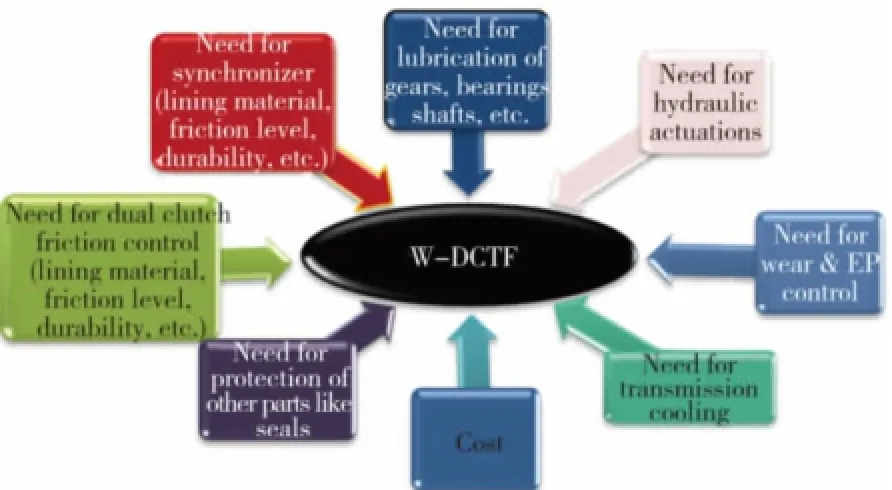
Figure 4 Unique W-DCTF specifications
In the applications of stepped ATs and CVTs,large OEMs have their own genuine fluids,which have been developed based on their unique specifications.For the service fill fluids,European OEMs and Japanese OEMs recommend their first-fill(genuine)fluids,except for North A-merican OEMs,who also approvemultivehicle service-fill fluids.The debates are continued on the concepts of universal fluids versus genuine fluids.Because of the severity of DCTF requirements,particularly for the first-fill DCTFs,we have been working closely with OEMs to develop customized DCTF technologies.
2 Custom ized DCTF Technologies
Table 1 summarizes viscosities and FZG EP performance of one commercial fluid,DCTF-FF,and three developmental fluids,DCTF-1,DCTF-2,and DCTF-3.DCTF-FF has been on themarket since 2002.When considering the number of DCT-based vehicles on the road since 2002,DCTF-FF represents the most widely used and commercially successful DCTF formulation style on themarket.In the public domain,there has been neither worker safety nor significant fluid-related field problems with the DCTF-FF fluid style since launch[7].
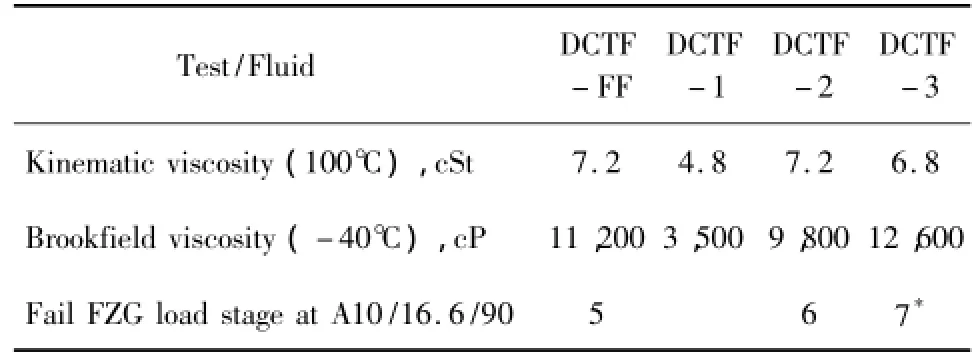
Table 1 Viscosities and FZG EP performance of DCT fluids
2.1 Two-Sum p DCTF Techno logy(FM-A),DCTF-1
DCTF-1 was designed for a two-sump DCT to lubricate and cool the wet clutches only.The lining material used for this development is FM-A.It is desired that DCTF-1 has high and stable dynamic and static friction,particularly high quasi-static friction,to have quick and smooth gear shifts and high torque capacity.To extend the drain interval of the fluid,DCTF-1 was developed in full synthetic base oils for better oxidative stability.To minimize the drag loss in the clutch pack,DCTF-1 was designed to have a low kinematic viscosity of 4.8 cSt at100℃and an extremely low Brookfield viscosity of 3,500 cP at-40℃.DCTF-1 is expected to have great fuel efficiency.
A GK rig was used for this development.Figure 5 shows the dynamic friction of DCTF-1 vs.test cycles.DCTF-1 gives high and stable dynamic coefficient of friction at 2700,1500,and 300 rpm in the test cycles.Themeasurementof the quasi-static friction was conducted immediately after the dynamic engagement.The clutch pack was still hot during the static frictionmeasurement.The quasi-static friction is considered a good indicator of the clutch torque capacity.The quasi-static friction is greater than 0.1 in all test conditions,for example,at 1.0 MPa and the sump temperature of 90℃(Figure 5)and 1.4 MPa and a higher sump temperature of 100℃(Figure 6).
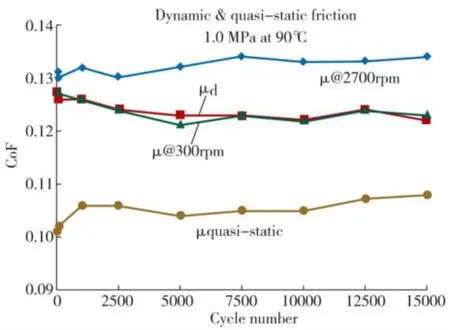
Figure 5 Dynam ic friction&quasi-static friction of DCTF-1 vs.test cycles in a GK test
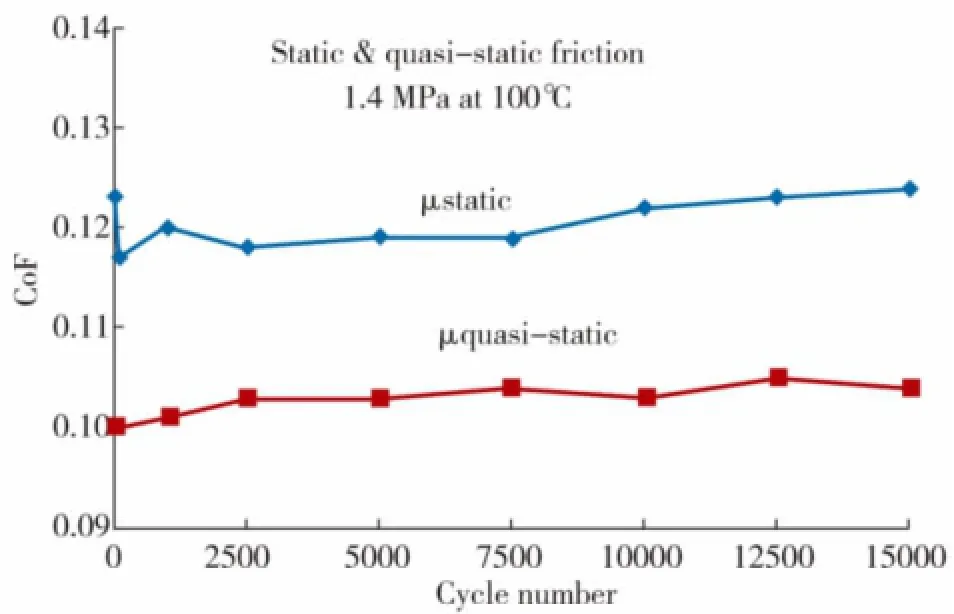
Figure 6 Static&quasi-static friction of DCTF-1 vs.test cycles in a GK test
A shudder search was conducted periodically during the dynamic engagements.Shudder phenomenon in the GK test is indicated by the oscillation of flange torque curves.DCTF-1 does not show any shudder tendency in the continuous slip at 100 rpm and speed controlled events at various test conditions such as different sump temperatures and clutch pressures at any time during the shudder search.Figure 7 shows the flange torque curve in the 300 seconds continuous slip at100 rpm in the test conditions of 1.0 MPa and 90°C after 15,000 dynamic engagement cycles.The flange torque curve does not show any oscillation phenomenon,i.e.,no shudder was observed.Figure 8 shows the flange torque curve at the controlled sliding speed test.The sliding speed was ramped from 0 to 300 rpm for 3 seconds,and stayed at 300 rpm for 2 seconds before the speed was decreased from 300 to 0 rpm for 3 seconds.Nearly no oscillation was observed in the flange torque curve,indicating no shudder event exists.
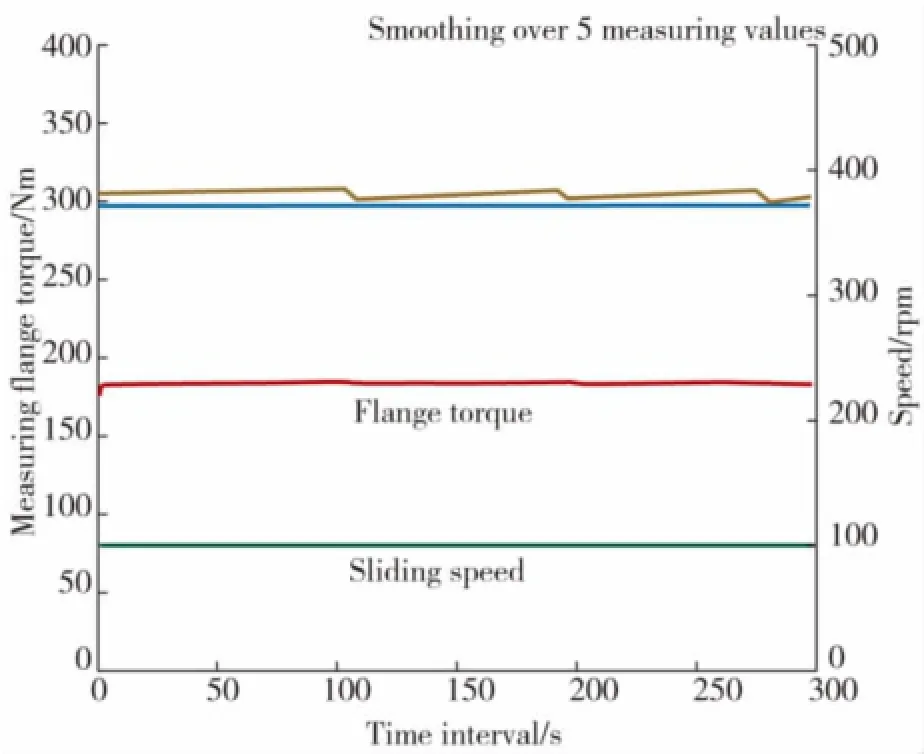
Figure 7 Flange torque of DCTF-1 in the continuous slip a t100 rpm after 15,000 dynam ic engagements.The test cond itions are 1.0 MPa of specific pressure and 90℃of sum p oil tem peratu re.

Figure 8 Flange torque of DCTF-1 in the speed contro lled shudder search event after 15,000 dynam ic engagements.The test conditions are 1.4 MPa of specific pressure and 100℃o f sum p oil tem pera ture.
2.2 One-Sum p DCTF Technology(FM-A),DCTF-2
DCTF-2 was fully formulated for a one-sump DCT to lubricate and to cool both the clutch pack and the gear box.The lining material used for this development is FM-A.DCTF-2 is blended in mineral base oils for cost reduction.As shown in Table 1,DCTF-2 gives a load stage higher than DCTF-FF in the FZG A/16.6R/90 EP test,which indicates that DCTF-2 has enough EP protection for gears.
DCTF-2 gives acceptable results in all bench and rig tests.The fluid performancewas further evaluated in a GTIvehicle.The vehicle test procedure was reported previous-ly[7-8].The vehicle test ismodeled on the 42,000 cycle GM cycling test,which representswell in excess of 100,000 customer road miles,and is part of the DEXRON®-VI fluid specification.At start-of-test,end-of-test(EOT)and at every ca.2,000 cycles in between,the used DCTF wasmicro-sampled and the vehiclewas evaluated for functional performance.DCTF-FF and DCTF-2 successfully completed the 42,000 cycles,and exhibited excellent shifting performance with no detectable issues at all.
The iron and copper concentrations in the oil samples weremeasured tomonitor wear performance.As shown in Figures9 and 10,themetal concentrations rise graduallywith increasing cycles after the transmission's break-in,i.e.,approximately the first 1,500 cycles.Considering the duration and severity of this test,the wear metal levels are relatively minor.DCTF-2 gives slightly lower wear metal concentrations in the oil samples than DCTF-FF.
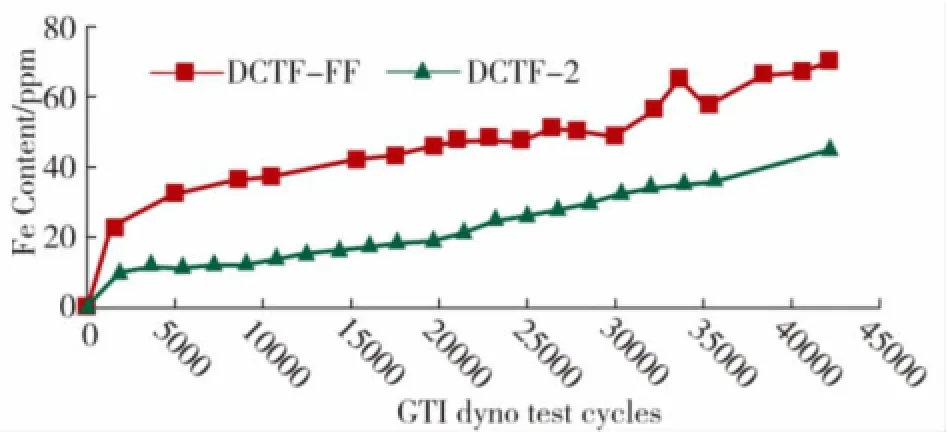
Figure 9 Iron concentrations in the oilsam ples vs.the test cycles
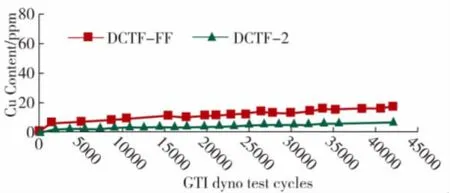
Figu re 10 Copper concentra tions in the oil sam p les vs.the test cycles
At the end-of-test,the transmissions were disassembled to inspect the DCT parts.All the DCT parts including pumps,gears,differentials,seals,gaskets,solenoids,friction plates,separator plates,synchronizers,etc.were found to be in excellent condition for both DCTF-FF and DCTF-2.Figures 11 and 12 show the photos of the EOT friction plates and synchronizer rings,which are in good shape.Certainly,since DCTF-FF is the factory fill fluid for this hardware application,such excellent performance is not too unexpected.
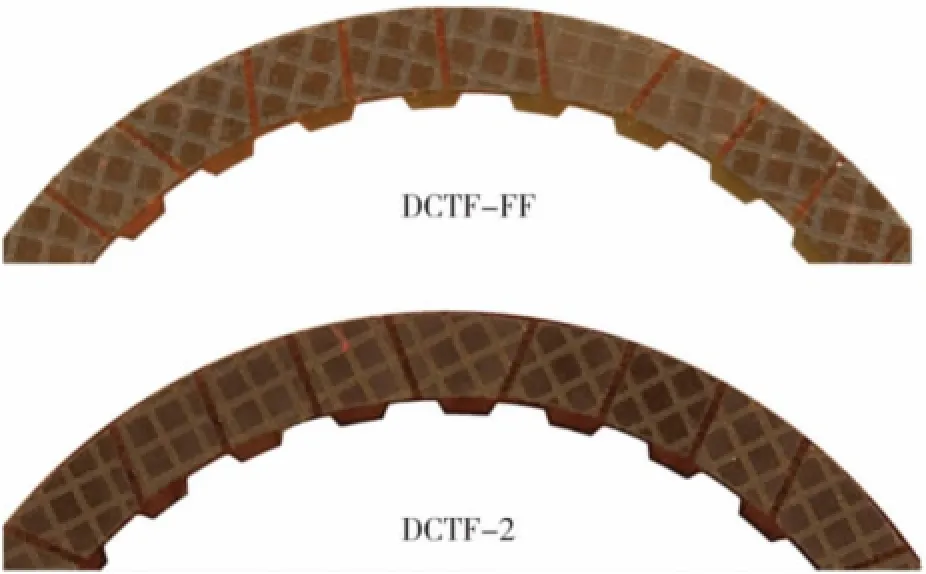
Figure 11 GTIclutch plates(FM-A)in excellent condition at EOT of the severe VW GTIchassis dynamometer tests on DCTF-FF and DCTF-2,respectively.The test covered 42,000 high-throttle,high-load cycles and 60,000 actualm iles on the dynamometer.
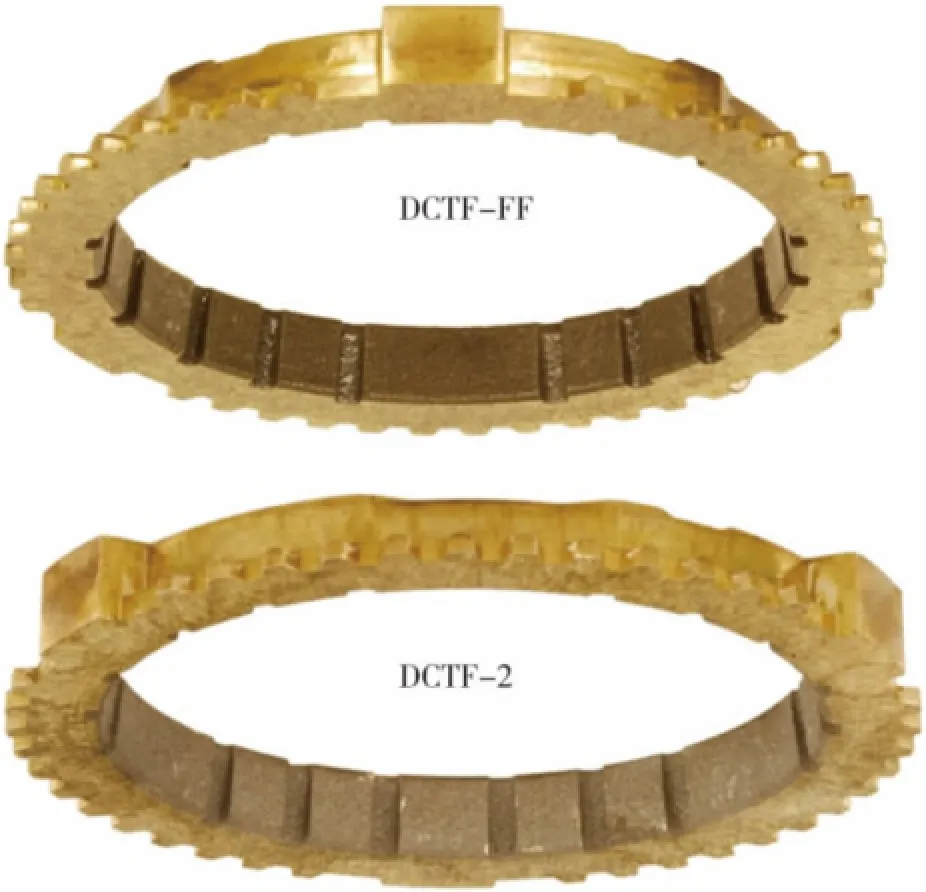
Figure 12 Synchronizers in excellent condition a t EOT from the severe VW GTIchassis dynamometer tests on DCTF-FF and DCTF-2,respectively.The test covered 42,000 high-throttle,high-load cycles and 60,000 actualm iles on the dynam ometer.
2.3 One-Sump DCTF Technology(FM-B),DCTF-3
DCTF-3 was fully formulated for a one-sump DCT to lubricate and to cool both the clutch pack and the gear box.Different to DCTF-2,DCTF-3 is developed for FM-B.As shown in Table 1,DCTF-3 gives two fail load stages higher than DCTF-FF in the FZG A/16.6R/90 EP test,which indicates that DCTF-3 has enough EP protection for gears.
A new plate clutch durability test procedure was developed,which ismore appropriate for DCTs than most standard industry stepped AT friction tests.The test is amodification of the SAE2DCT test we reported previously[7].The new SAE test has two friction plates to simulate the real clutch pack with multiple friction plates,rather than one friction plate used in our previous SAE2DCT test.This new SAE test contains dynamic engagement aging blocks and friction mapping blocks.The dynamic engagement is conducted at1.51MPa of specific pressure and 120℃sump temperature.Figure 13 shows the mid-point dynamic(μd)and low-speed dynamic(μ0)coefficients of friction of DCTF-3 with test cycles,which keep consistentwith test cyclesafter break-in,indicating DCTF-3 gives stable dynamic friction on FM-B.The dynamic friction ratio ofμ0/μdis less than 1.0 sinceμdis greater than μ0,indicating that DCTF-3 does nothave a shudder tendency in this severe 20,000 dynamic engagement test.
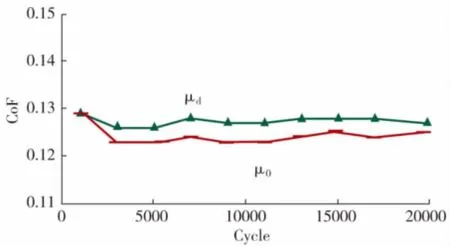
Figu re 13 Dynam ic friction o f DCTF-3 on FM-B in a proprietary SAE test
The fluid durability was further evaluated on the low velocity friction apparatus(LVFA)on FM-B according to JASOM349 procedure.DCTF-3 gives excellent LVFA durability over 720 hours as shown in Figure 14,indicating DCTF-3 delivers excellent friction durability without any shudder tendency in an extended life.
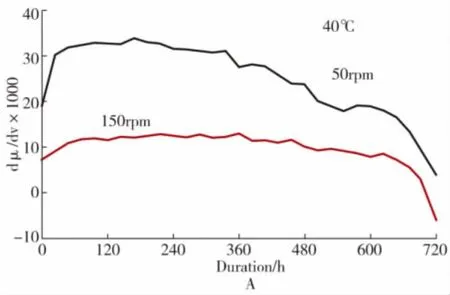
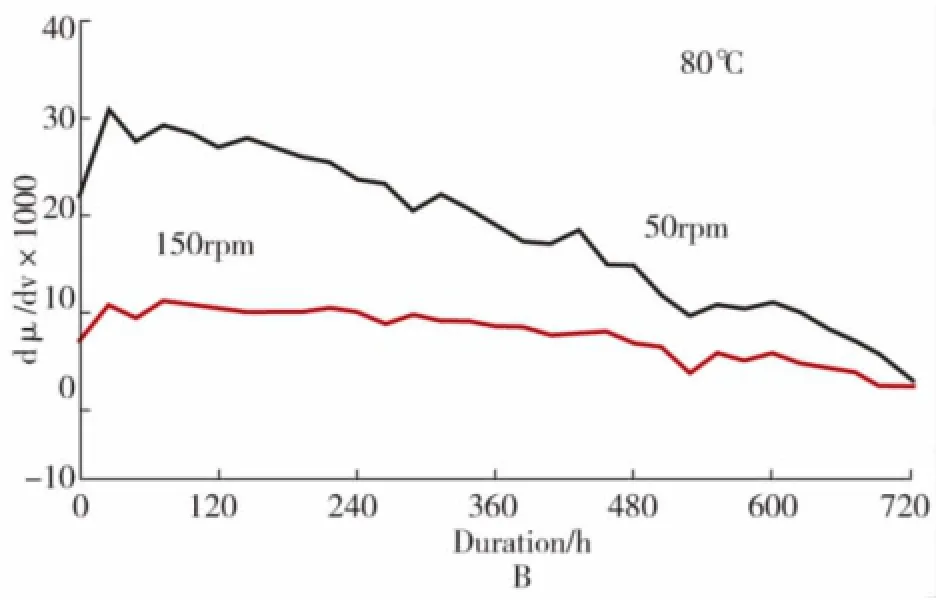
Figure 14 LVFA durability results of DCTF-3 on FM-B:A)at40℃,B)at80℃
3 Summ ary
OEMs have already launched orwill launch wet DCTs after the first launch by VW in 2002 due to the overall benefits including fuel efficiency,torque transmitting capacity,durability,cost,packaging,driving comfort and sportiness.Many breakthroughs have beenmade to further improve the fuel efficiency by design innovations and introductions of new parts,for example,electric on-demand lubrication pumps,new friction liningmaterial,etc.
Each W-DCT has its unique design,hence different part selections.It demands the lubricant to provide excellent wet clutch friction performance and anti-shudder friction durability,good synchronizer friction performance and durability,high load-carrying ability,excellent bearing performance,strong anti-corrosion performance,high thermal and oxidative stability,excellent compatibility,etc.Particularly,the requirementofwet clutch friction performance is extremely demanding,much more severe than conventional ATFs and CVTFs.New W-DCT fluid technologiesmust be developed tomeet the unique specification of each W-DCT design and part selections.
DCTF-1 was optimized for a two-sump W-DCT application with the clutch liningmaterial of FM-A.DCTF-1 shows high and stable dynamic friction,static friction,particularly high quasi-static friction of>0.1,in the GK test.DCTF-1 does not show any shudder tendency in the extensive shudder search procedures.
DCTF-2 was designed for a one-sump W-DCT application with the same clutch lining material of FM-A.Both DCTF-2 and the factory-fill DCTF-FF completed 42,000 cycles of the severe chassis dynamometer vehicle test involving a Volkswagen GTI.No significant damage or wear was ob-served ormeasured from end of test transmission parts.
DCTF-3 was developed for a one-sump W-DCT application with the clutch liningmaterial of FM-B.DCTF-3 shows high and stable dynamic friction in the severe newly developed SAE DCT test procedure.DCTF-3 also gives excellent LVFA durability of over 720 h in JASO M349 test procedure on FM-B.
Acknow ledgements
The authors thank coworkers at Afton's automatic transmission fluid research labs in Japan(Takuo Takano,Carl-Patrik Morand),England and the United States(Randy M.Rousseau,David K.Harris,Dave Strait,Kevin Strait,Dave Harer,Dennis C.Fitzgerald,Martin Rose,Daniel Long,Matt Sangpeal,and Andrew Fitzgerald)for their help.Appreciation is noted for the special assistance from Afton colleagues including Dr.Matthew S.Newkirk,Dr.Harald Maelger,Dr.Anthony Rollin,Jeff Milner,Yun Zhang,Walter Kudlich,Dr.Y.Murakami,Tracy McCombs and Kenji Yatsunami.The authors also thank Professor Timothy M.Cameron(Miami University of Ohio)for fruitful discussion.
[1]Alexander Moser,Viren Saxena,Paul McCrary.BorgWarner DualTronic®Transmission Concepts for Efficiency,Cost&Robustness[C]//CTI Symposium Innovative Automotive Transmissions.Germany,2008.
[2]Alexander Moser,Viren Saxena,Michael Ritschel.Cost and Efficiency Optimized DCT Concept[C]//9th International CTISymposium and Exhibition.Germany,2010.
[3]Mirko Leesch,Jörg Müller,Rico Resch,et al.A New 9-Speed Hybrid Dual Clutch Transmission for Transverse Applications up to 450 Nm Input Torque[C]//9th International CTISymposium and Exhibition.Germany,2010.
[4]SHurley,CD Tipton,SPCook.Additives for Dual Clutch Transmission Lubricants[C]//SAE Paper 2006-01-3245.
[5]Bernd Matthes.Dual Clutch Transm issions-Lessons Learned and Future Potential[C]//SAE Paper 2005-01-1021.
[6]Robert C Lam,Bulent Chavdar,Tim Newcomb.New Generation Friction Materials and Technologies[C]//SAE Paper 2006-01-150.
[7]Samuel H Tersigni,Timothy JHenly,Ramnath N Lyer,et al.Designing DCT Fluids for Safety,Durability and Fuel Efficiency[C]//SAE Paper 2008-01-0250.
[8]Samuel H Tersigni,Hong-Zhi Tang,Ramnath N Lyer,et al.Durability of Dual Clutch Transmission Fluids[C]// SAE Paper 2009-01-1801.
TE624.82
A
1002-3119(2012)02-0022-08
2011-08-19。
Hong-Zhi(Tom)Tang,male,is an ATF formulator of Afton Chemical Corporation.He hasbeen developing stepped automatic transmission fluids,continuously variable transmission fluids,dual clutch transmission fluids,and hybrid electric or pure electric transmission fluids after he joined Afton Chemical Corporation in May,2007.Since he was awarded the Ph.D.degree in 1999 from Japan Advanced Institute of Science and Technology(JAIST),he has worked in MEC Laboratory of Daikin Industries Ltd.and NTT Basic Research Laboratory in Japan.He has done post-doc research in University ofWashington,North Carolina State University and Lawrence Berkeley National Laboratory from 2002 to 2007.He has published two international patents and 35 scientific/technical papers.He has given over 20 presentations.
